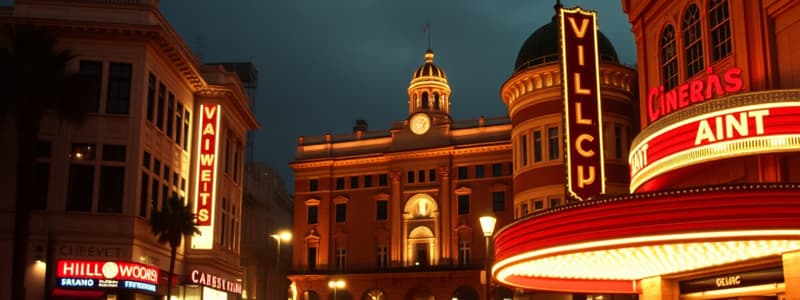Podcast
Questions and Answers
What is Classical Hollywood Filmmaking?
What is Classical Hollywood Filmmaking?
Make sure your main character wants something. Emphasize conflict. Takes your character on an emotional journey. Be sure that your ending resolves the initial situation.
What is Classical Hollywood Cinema?
What is Classical Hollywood Cinema?
A cinema tradition that dominated Hollywood production from the 1930s to the 1960s.
Classical Hollywood Cinema became the most powerful and dominant style of filmmaking worldwide.
Classical Hollywood Cinema became the most powerful and dominant style of filmmaking worldwide.
True (A)
The style of Classical Hollywood Cinema is easily detectable by the average spectator.
The style of Classical Hollywood Cinema is easily detectable by the average spectator.
Give an example of a Classical Hollywood film.
Give an example of a Classical Hollywood film.
Who coined the term Classical Hollywood Cinema?
Who coined the term Classical Hollywood Cinema?
What is meant by 'classical Hollywood style'?
What is meant by 'classical Hollywood style'?
Classical Hollywood style became paradigmatic due to the global dominance of Hollywood cinema.
Classical Hollywood style became paradigmatic due to the global dominance of Hollywood cinema.
What are the seven features of Classical Hollywood Cinema?
What are the seven features of Classical Hollywood Cinema?
What is the three-act narrative structure?
What is the three-act narrative structure?
Describe how narratives contain cause and effect.
Describe how narratives contain cause and effect.
In Classical Hollywood films, situations are typically resolved without any closure.
In Classical Hollywood films, situations are typically resolved without any closure.
What constitutes a classical narrative style?
What constitutes a classical narrative style?
How must the elements of a classical narrative be arranged?
How must the elements of a classical narrative be arranged?
Classical Hollywood filmmakers primarily rely on psychological motivations to drive events.
Classical Hollywood filmmakers primarily rely on psychological motivations to drive events.
What is meant by motivation in classical narrative film?
What is meant by motivation in classical narrative film?
What characterizes objective storytelling in Hollywood films?
What characterizes objective storytelling in Hollywood films?
In what way does objective storytelling provide an omniscient perspective?
In what way does objective storytelling provide an omniscient perspective?
What does 'character driven' mean in the context of American cinema?
What does 'character driven' mean in the context of American cinema?
In character driven films, characters are arranged in a hierarchy from protagonist to antagonist.
In character driven films, characters are arranged in a hierarchy from protagonist to antagonist.
What are some examples of character driven films?
What are some examples of character driven films?
What does 'mise-en-scene' refer to?
What does 'mise-en-scene' refer to?
How does mise-en-scene contribute to a film?
How does mise-en-scene contribute to a film?
Flashcards are hidden until you start studying
Study Notes
Classical Hollywood Filmmaking
- Main character is driven by a clear desire, leading to conflict and emotional journeys.
- Ends of films typically resolve the initial conflict, providing closure.
Classical Hollywood Cinema
- Dominated Hollywood production from the 1930s to the 1960s, establishing a filmmaking tradition.
- Evolved into a globally influential filmmaking style, gaining massive popularity and recognition.
- Exhibits an invisible style, often unnoticed by the average spectator.
Notable Examples
- Films such as "Casablanca" and "Citizen Kane" exemplify classical Hollywood filmmaking.
Terminology and Contributors
- The term "Classical Hollywood Cinema" was coined by scholars David Bordwell, Janet Staiger, and Kristin Thompson in their influential study.
Classical Hollywood Style
- A distinctive cinematic style grew between 1917 and 1960, characterized by clarity and formal consistency.
- This style became paradigmatic due to Hollywood's global impact on cinema.
Features of Classical Hollywood Cinema
- Key features include a three-act narrative, objective storytelling, character-driven plots, mise-en-scene elements, and classical continuity editing.
- Reality-effect is a significant aspect, enhancing audience connection to the story.
Narrative Structure
- Hollywood narratives adhere to a three-act structure: orientation, complication, and resolution.
- Narratives highlight a clear cause-and-effect sequence that drives the plot forward.
Objective Storytelling
- Audiences are privy to more information than characters, creating a god-like perspective that allows insight into various narrative threads.
Character-Driven Stories
- American cinema emphasizes individual characters' journeys and motivations, forming the foundation of plot development.
- Characters are hierarchically arranged, influencing their interactions and story arcs.
Mise-en-Scene
- Originating from theater, mise-en-scene refers to the aesthetic arrangement of actors, sets, and props within a frame.
- Contributes to the film's mood, helping audiences engage deeply with the story and its characters through visual storytelling.
Studying That Suits You
Use AI to generate personalized quizzes and flashcards to suit your learning preferences.





